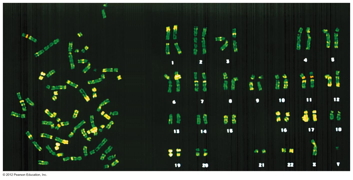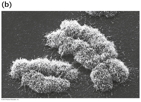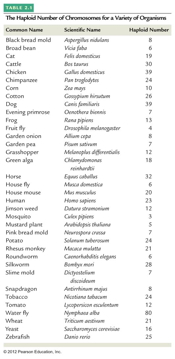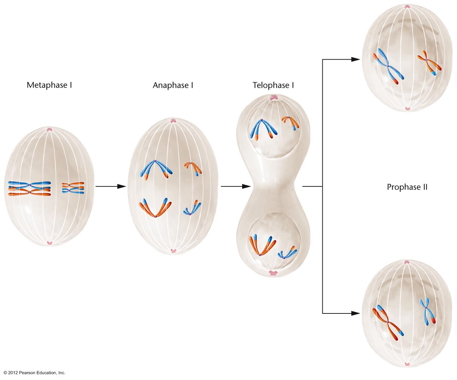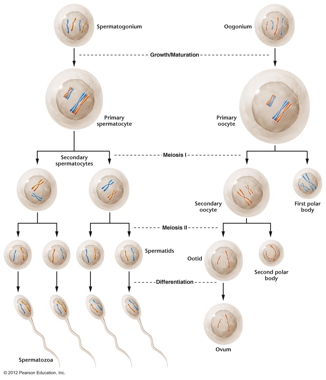|
Asexual Cell Division:
Asexual cell division makes identical cells where as
sexual cell division makes non-identical cells.
(Diploid and haploid, 2n and 1n.) Diploid cells have
homologous pairs. Haploid cells do not. We will
concentrate on eukaryotic cell division, but
prokaryotes also divide (a simper process).

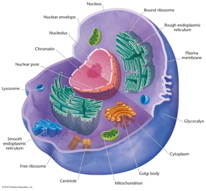
-
Chromosomes:
Chromosomes are composed primarily of DNA and
protein (more detail later). The number of
chromosomes varies greatly from organisms to
organism.
- DNA: The DNA
molecule of a eukaryotic chromosome is one long
linear molecule.
- Protein: Eukaryotic
chromosomes actually have more protein than DNA
(by molecular weight). The most abundant protein
bound to eukaryotic chromosomes is the class of
basic proteins called histones (rich in basic
amino acids=plus charge; DNA has negative
charge).
|
-
The
Cell Cycle: Dividing cell are
undergoing the cell cycle: G1 (and G0), S, G2, M
(G1=gap 1, S=synthesis, G2=gap 2, M=mitosis).
During mitosis both karyokinesis and cytokinesis
occur. The pair of centrioles replicates before
mitosis in G2 creating 2 pairs of centrioles.
- Cell Cycle
Checkpoints: There are at
least three checkpoints beyond which the cycle
will not proceed if certain events occur (or
don't occur).
- The G1/S
checkpoint: The cell checks to make
sure the cell if of sufficient size and
there is no DNA damage
- The G2/M
checkpoint: DNA replication must be
complete and the DNA must be undamaged in
order for the cell to proceed beyond this
checkpoint.
- The M
checkpoint: The cell checks to
insure that the spindle apparatus has
properly formed.
- The Stages of
the Cell Cycle:
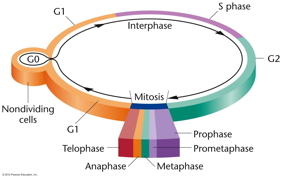 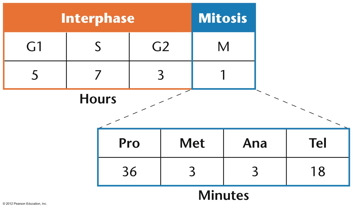
- G1:
This is the stage for DNA replication
preparation.
- S: This is the stage during
which DNA replication (chromosome
replication) occurs.
- G2: This is the stage for
mitosis preparation.
|
- M phase (Mitosis): Mitosis
is the stage during which the visible events
of cell division occur and the replicated
chromosomes segregate to separate daughter
cells. Mitosis is the type of cell division
that makes a multicellular organism from a
fertilized egg, replaces old cells,
regenerates organs, and is a means of asexual
reproduction for many organisms. Mitosis is
divided into four stages.
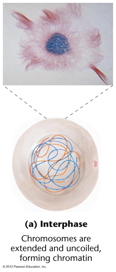 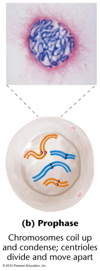 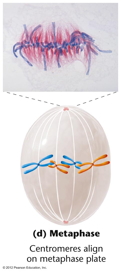 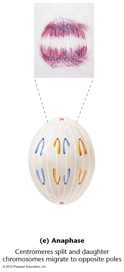 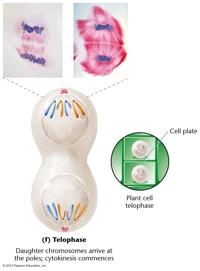
- Prophase:
During prophase, chromosomes condense,
nuclear membrane disappears, nucleolus
disappears, and the spindle apparatus forms.
Spindle fibers attach to the kinetochore of
the centromere. As chromosomes become
visible, it is obvious that chromosome
replication has occurred (each chromosome is
made up of two sister chromatids held
together at the centromere).
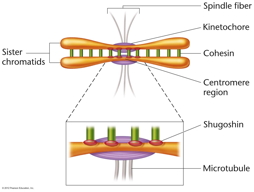
- Metaphase: During
metaphase, chromosomes line up along
equatorial plane and chromosomes are most
easily observed. Karyotyping is done using
metaphase (or prometaphase) chromosomes. The
protein cohesin holds the sister chromatids
together. Chromosomes are classified
according to their size and the position of
their centromeres. This is expressed as the
chromatid arm ratio. The short arm of the
chromatid is represented by p and
the long arm by q, so
chromosomes are classified by the q/p
ratio.
|
- Metacentric:
Metacentric chromosomes have their
centromeres more or less in the middle (q/p =
1.0 - 1.7)
- Submetacentric:
The centromere is located nearer to one
end (q/p
= 1.7 - 3.0)
- Acrocentric:
The centromere is located very near one
end (q/p
= 3.0 - 7.0)
- Telocentric:
The centromere located almost at the end (q/p ≥
7.0). Humans have no true telocentric
chromosomes.
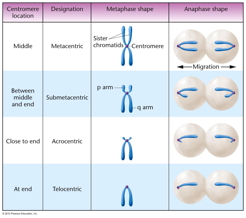
|
- Anaphase:
Sister chromatids (now chromosomes) disjoin
and move to opposite poles. The movement
occurs due to molecular motors and the
microtubules of the spindle.
|
- Telophase:
The events of prophase are reversed and
cytokinesis occurs. In plants, a cell
plate (middle lamella) forms between
the two poles. In animals, a cleavage furrow
pinches the cell in two.
|
|
Sexual
Cell Division: Meiosis: Meiosis is a
process that produces 4 haploid cells beginning with
one diploid cell through two divisions: meiosis I
and meiosis II. Meiosis I is sometimes call a
reductional division (?) and meiosis II an
equational division (?). In higher organisms,
meiosis occurs in the sex organs and produces
haploid egg and sperm. Meiosis produces cells that
are genetically distinct from each other and from
the mother cell (i.e., it is a sexual process).
|
|
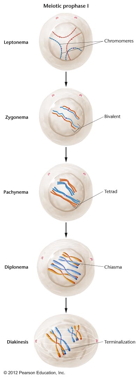
-
Leptonema (-tene): This is
the stage when chromosome condensation
begins. (It continues throughout prophase
I.) Chromomeres may be present.
-
Zygonema (-tene): Synapsis
(pairing) occurs during zygonema with the
appearance of the proteinaceous synaptonemal
complex, made up of two lateral elements and
one central element. Synapsis may start in
the end of the chromosomes, the telomeres,
which may be bound to the nuclear membrane.
It proceeds as the chromosomes "zip up"
toward the centromere. Condensation
continues.
-
Pachynema (-tene): Tighter
pairing and crossing over occurs at this
stage. (Details later in the course under
Molecular Recombination.) Recombination
nodules may appear on the synaptonemal
complex during pachynema and are thought to
be the sites of crossing over. (There
is a correlation between these nodules and
crossovers.)
-
Crossing Over: Crossing
over usually occurs between a pair of
chromosomes with most showing double,
triple, quadruple (or more) crossovers.
However, where along the chromosome the
crossover occurs varies with each meiosis.
Double crossover may be two-strand,
three-strand, or four-strand double
crossovers.
-
Diplonema (-tene): The
synaptonemal complex disappears and pairing
is relaxed. However, chromosomes are still
held together at the site of the crossovers
(chiasmata).
-
Diakinesis: The homologous
pairs continue to pull apart and
terminalization of the chiasmata is seen
(the chiasmata slip toward the telomeres).
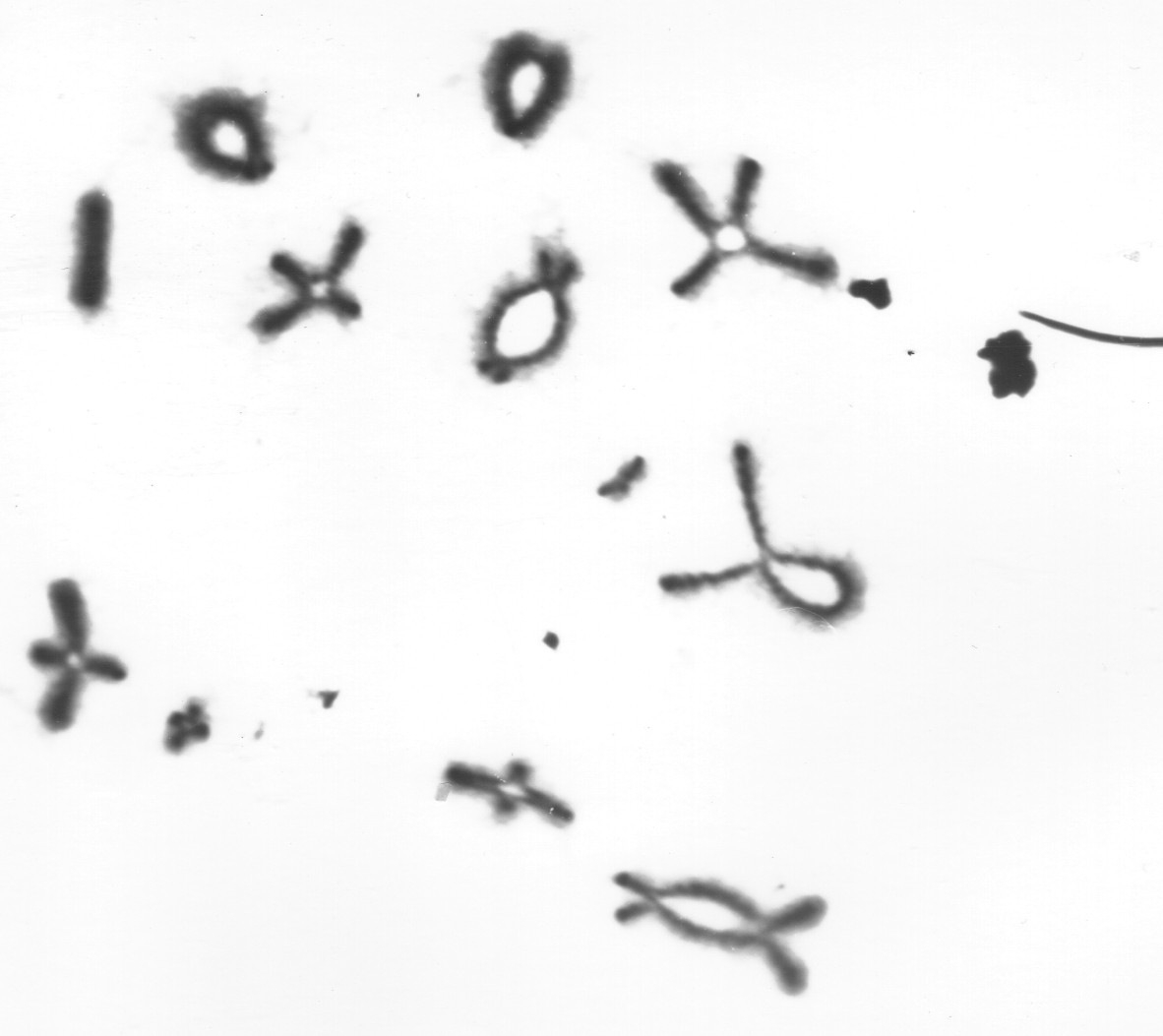 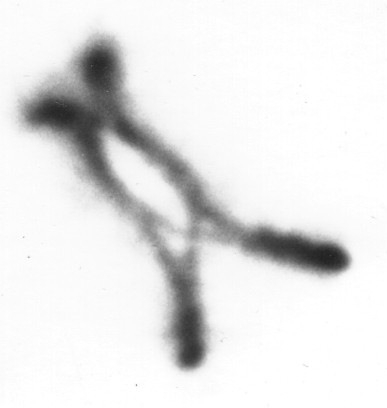
|
- Telophase
I: Cytokinesis divides the
cell into two cells.
|
|
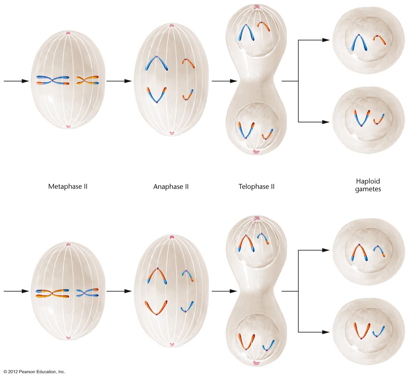
When did
reductional division occur? See quote
from "Genetics" by Strickberger, Macmillan, also
this one from "An
Introduction to Genetics" by Merrell, Norton &
Co.)
|
-
Terminology:
Tetrad, Bivalent, Dyad,
Monad: The paired chromosomes at
prophase I can be called a tetrad or bivalent. A
chromosome consisting of just one chromatid is a
monad. If it has two chromatids, it is a dyad.
-
Variations: In
males, the above pattern is followed: 2n
spermatogonia become primary spermatocytes
(cells in the middle of meiosis I) which become
secondary spermatocytes (cells in the middle of
meiosis II), which become 1n spermatids. These
lose most of their cytoplasm and grow a
flagellum and become sperm. In females, the same
pattern is observed (oogonia and oocytes), but
cytokinesis at telophase I and II is unequal
producing a primary and a secondary polar body
which do not survive. Timing of meiosis:
Prophase I arrest in human females. Meiosis II
not completed until after fertilization. (Eggs
may be made throughout adulthood?)(Or
may NOT?)
-
So, what is the chance that any two
human sperm will be identical??
|
 Home
Home Lectures
Lectures Online
Online Tests
Tests Extra
Extra

